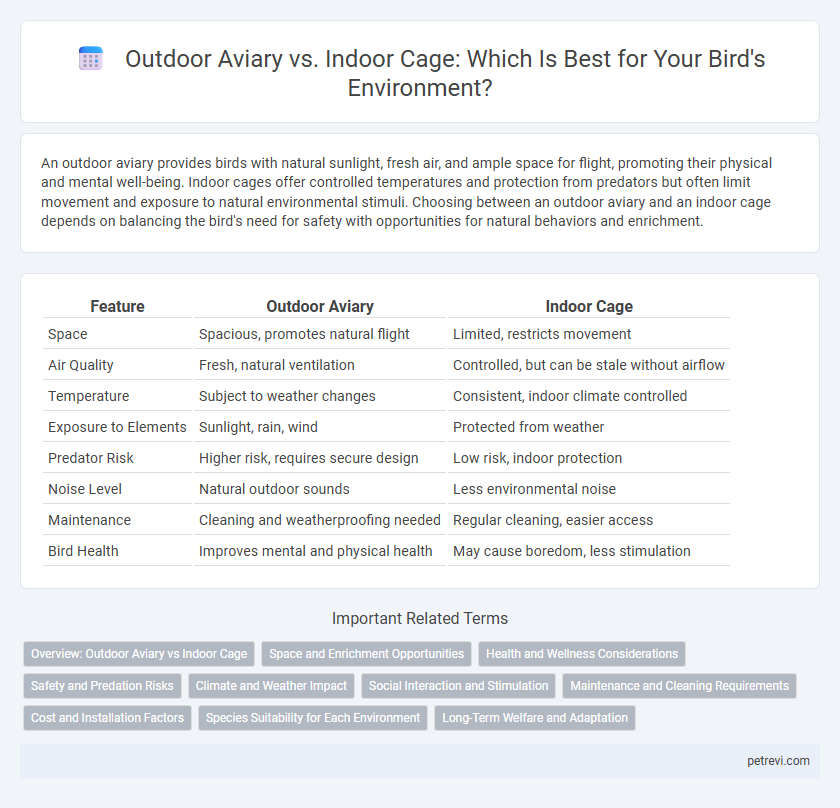An outdoor aviary provides birds with natural sunlight, fresh air, and ample space for flight, promoting their physical and mental well-being. Indoor cages offer controlled temperatures and protection from predators but often limit movement and exposure to natural environmental stimuli. Choosing between an outdoor aviary and an indoor cage depends on balancing the bird's need for safety with opportunities for natural behaviors and enrichment.
Table of Comparison
| Feature | Outdoor Aviary | Indoor Cage |
|---|---|---|
| Space | Spacious, promotes natural flight | Limited, restricts movement |
| Air Quality | Fresh, natural ventilation | Controlled, but can be stale without airflow |
| Temperature | Subject to weather changes | Consistent, indoor climate controlled |
| Exposure to Elements | Sunlight, rain, wind | Protected from weather |
| Predator Risk | Higher risk, requires secure design | Low risk, indoor protection |
| Noise Level | Natural outdoor sounds | Less environmental noise |
| Maintenance | Cleaning and weatherproofing needed | Regular cleaning, easier access |
| Bird Health | Improves mental and physical health | May cause boredom, less stimulation |
Overview: Outdoor Aviary vs Indoor Cage
Outdoor aviaries offer birds a spacious, natural environment with ample sunlight and fresh air, promoting physical activity and mental stimulation. Indoor cages provide a controlled climate that protects birds from predators and harsh weather but may limit space and natural experiences. Choosing between an outdoor aviary and indoor cage depends on balancing environmental enrichment with safety and maintenance considerations.
Space and Enrichment Opportunities
Outdoor aviaries typically provide birds with significantly more space and natural enrichment opportunities such as sunlight, fresh air, and diverse foliage that promote physical and mental well-being. Indoor cages often limit birds' movement and environmental stimulation, potentially leading to boredom and stress-related behaviors. Optimal bird care involves creating an environment with ample space and varied enrichment to support natural behaviors and overall health.
Health and Wellness Considerations
Outdoor aviaries provide birds with fresh air, natural sunlight, and more space to fly, promoting better physical health and mental stimulation. Indoor cages offer controlled climate conditions, protection from predators, and reduced exposure to parasites, enhancing safety and consistent wellness. Balancing outdoor exposure with indoor security optimizes respiratory health, stress reduction, and overall well-being for pet birds.
Safety and Predation Risks
Outdoor aviaries provide birds with natural sunlight and fresh air but expose them to greater predation risks from cats, hawks, and other predators, requiring robust materials and secure locks to ensure safety. Indoor cages offer controlled environments that protect birds from weather extremes and predators, significantly reducing injury or escape risks while allowing closer monitoring of their health. Choosing between an outdoor aviary and an indoor cage depends on balancing the benefits of natural stimulation against the necessity of predator protection and environmental safety.
Climate and Weather Impact
Outdoor aviaries provide birds with natural sunlight, fresh air, and exposure to varying temperatures that support their physical and psychological well-being, but they require weatherproof designs to protect against rain, wind, and extreme heat or cold. Indoor cages offer controlled climate conditions, minimizing risks from harsh weather fluctuations, temperature extremes, and humidity changes, which is especially beneficial for tropical or delicate bird species. Proper ventilation, insulation, and temperature regulation are critical in both settings to prevent stress, illness, and behavioral issues caused by inappropriate climate exposure.
Social Interaction and Stimulation
Outdoor aviaries provide birds with increased social interaction opportunities by allowing multiple birds to coexist in a spacious environment that mimics natural habitats, enhancing mental stimulation through exposure to natural sounds and varied weather conditions. Indoor cages limit social engagement to occasional human interaction and confined space, reducing the bird's exposure to environmental stimuli essential for cognitive development. Choosing an outdoor aviary promotes healthier social behavior and dynamic stimulation critical for a bird's overall well-being.
Maintenance and Cleaning Requirements
Outdoor aviaries require regular inspection to prevent weather damage and control pest infestations, with routine cleaning needed to remove droppings and food debris to maintain hygiene. Indoor cages demand frequent cleaning to manage odors and bacteria buildup in confined spaces, often necessitating daily spot cleaning and weekly deep cleans to ensure a healthy environment. Both setups benefit from using non-toxic cleaning agents and removable trays for efficient waste disposal, supporting optimal bird health and wellbeing.
Cost and Installation Factors
Outdoor aviaries typically require a higher initial investment due to robust weather-resistant materials and secure foundations, while indoor cages are more affordable and easier to install, often requiring minimal assembly space. Maintenance costs for outdoor aviaries can be higher because of exposure to elements, necessitating frequent repairs and durable protective coatings, whereas indoor cages incur lower upkeep expenses in a controlled environment. Installation time for outdoor aviaries ranges from days to weeks depending on size and complexity, contrasting with the quick setup of indoor cages that can often be completed within hours.
Species Suitability for Each Environment
Outdoor aviaries provide ample space and natural light, making them ideal for species such as finches, canaries, and parrots that thrive in a more naturalistic environment. Indoor cages suit smaller or more delicate birds like budgerigars, cockatiels, and lovebirds, which require controlled temperatures and protection from predators. Choosing the right environment depends on specific species' needs for space, climate, and social interaction.
Long-Term Welfare and Adaptation
Outdoor aviaries provide birds with natural sunlight, fresh air, and a more spacious environment, promoting better physical health and mental stimulation, which are crucial for long-term welfare. Indoor cages, while protecting birds from harsh weather and predators, often limit flight space and natural behaviors, potentially leading to stress and obesity if enrichment is insufficient. Adapting birds to their environment requires careful monitoring of temperature, humidity, and social interaction to ensure optimal health and psychological well-being over time.
Outdoor Aviary vs Indoor Cage for Bird Environment Infographic

 petrevi.com
petrevi.com